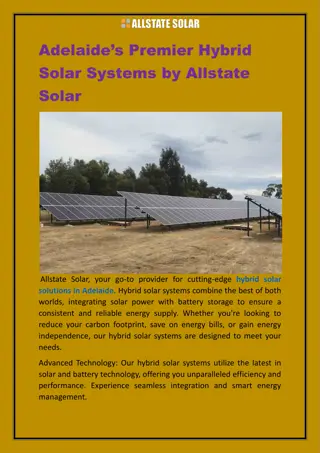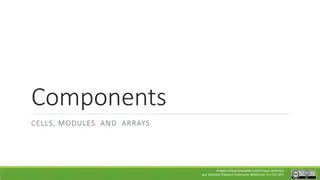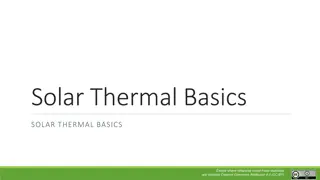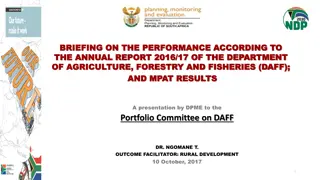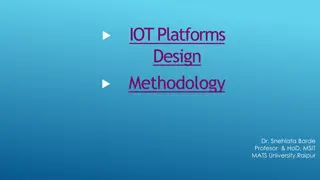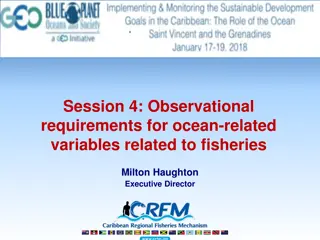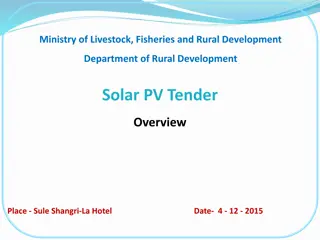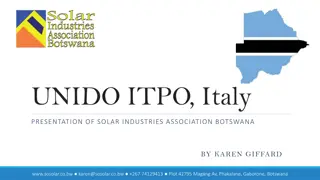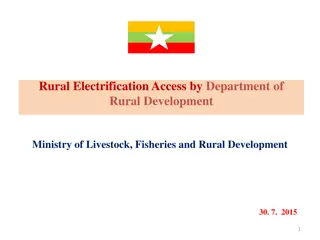Solar Home System Standard Specification by Ministry of Livestock, Fisheries, and Rural Development
Draft for discussion on solar home system standards set by the Ministry of Livestock, Fisheries, and Rural Development. The document outlines specifications for three different systems, including power capacities, battery storage, LED lumens, and more. It also details certification standards for PV modules and warranty information.
Uploaded on Sep 11, 2024 | 0 Views
Download Presentation

Please find below an Image/Link to download the presentation.
The content on the website is provided AS IS for your information and personal use only. It may not be sold, licensed, or shared on other websites without obtaining consent from the author.If you encounter any issues during the download, it is possible that the publisher has removed the file from their server.
You are allowed to download the files provided on this website for personal or commercial use, subject to the condition that they are used lawfully. All files are the property of their respective owners.
The content on the website is provided AS IS for your information and personal use only. It may not be sold, licensed, or shared on other websites without obtaining consent from the author.
E N D
Presentation Transcript
Ministry of Livestock, Fisheries and Rural Development Department of Rural Development Solar Home System Standard Specification (Draft for Discussion ) Place - Sule Shangri-La Hotel Date- 4 - 12 - 2015
System-1 Minimum power of solar PV array: 30Wp Minimum battery storage capacity : 12V/20Ah (Lead-acid)(50%DoD) : 12V/12Ah (Li-ion)(90% DoD) Charge controller : 12V/2A (PWM type) Minimum DC LED lumens: 240 Lumens ( 80lumen/watt)- 3nos -3.5hr DC socket outlet : USB type ( for cell-phone charging 2.5hr) 12V/2A DC socket outlet: 15W DC TV (1.2hr) A wiring kit of appropriate size for All DC wiring Balance of system materials including: mounting structure, battery box, battery fuse, cabling, light switches, User Manual and O&M manual 2
System-2 Minimum power of solar PV array: 45Wp Minimum battery storage capacity : 12V/30Ah (Lead-acid)(50%DoD) : 12V/16Ah (Li-ion)(90% DoD) Charge controller : 12V/3A (PWM type) Minimum DC LED lumens: 240 Lumens ( 80lumen/watt)- 4nos -4hr DC socket outlet : USB type ( for cell-phone charging 2.5hr) 12V/2A DC socket outlet: 15W DC TV (1.8hr) A wiring kit of appropriate size for All DC wiring Balance of system materials including: mounting structure, battery box, battery fuse, cabling, light switches, User Manual and O&M manual 3
System-3 Minimum power of solar PV array: 60Wp Minimum battery storage capacity : 12V/40Ah (Lead-acid)(50%DoD) : 12V/23Ah (Li-ion)(90% DoD) Charge controller : 12V/5A (PWM type) Minimum DC LED lumens: 240 Lumens ( 80lumen/watt)- 5nos -5hr DC socket outlet : USB type ( for cell-phone charging 2.5hr) 12V/2A DC socket outlet: 15W DC TV (3hr) A wiring kit of appropriate size for All DC wiring Balance of system materials including: mounting structure, battery box, battery fuse, cabling, light switches, User Manual and O&M manual 4
PV modules Certification standards Crystalline Modules: Mono-crystalline , Poly-crystalline IEC 61215 (2005-04),IEC 61646 certified module, ISO 9001 certification Crystalline Modules have 36 cells for 12V batteries Tolerance of rated output of PV modules offered shall be positive only Warranty: 10 years
Continue - PV modules Solar Module shall be warranted to produce at least 80% of rated peak watt output for at least 10 years. Solar module should have a full replacement warranty if it fails within one year due to manufacturing or material defect. The module shall be labeled indicating at a minimum Manufacturer, Model Number, Serial Number, Peak Watt Ratting, Voltage and Current at peak power, Open Circuit Voltage and Short Circuit Current of each module.
Batteries Certification standards IEC 61427 Ed. 2.0 (2004-05), IEC 60896-11; Ed 1.0 (2002), IEC 60896-21 and 22 Ed 1 (2004) ,ISO 9001 Certificates or equivalent standards i.e IEEE, may be proposed by suppliers Lead-acid: deep-cycle, heavy-duty, tubular positive plate, with immobilized electrolyte and valve regulated operation(75%) loadshed DoD) Lead-acid: deep-cycle, heavy duty, tubular positive plate with vented and flooded electrolyte cell(75% loadshed DoD) Li-ion : deep-cycle, heavy-duty, sealed( 90% maximum loadshed DoD)
Continue-Batteries Battery capacity shall not be less than 80% of rated capacity over a period of 18 months 12V Lead acid battery wet weight of at least 0.35kg per rated ampere-hour(C/10rate)(eg. 58Ah battery must weigh at least 58 x 0.35 = 20.3 kg) Battery cycle life at 50% daily depth-of-discharge (DOD) must exceed 1,800 cycles Battery shall offer at least a four year useful life
The battery shall be housed in a vented compartment. All parts of the compartment subject to battery acid contact shall be acid resistant. This compartment shall be built strong enough to accommodate the weight of the battery. Fig 2.Sample of Battery 9
Charge controller Certification standards EC 62509 Ed.1, IEC 62109, IEC 62093 Ed.1.0, IEC 17025, IECEE standard, ISO 9001 certified manufacturer Solid state photovoltaic charge controller, Pulse Width Modulated(PWM) regulation Controller shall have a charging regime applicable to battery with voltage setpoints preset at factory Controller shall have LED indicator lights or meter to show state of charge and when the battery is in a charging mode Controller shall have protection against short circuit of input and output terminals as well as reverse polarity protection
Charge Controller configuration fig. Sample of charge controller Electronic automatically resettable cut-offs are required- mechanical fuses are not acceptable Controller shall be able to safely accept 125% of the module open-circuit voltage when battery is removed
LED luminaires Certification standards: Compliant with Lighting Global Standard, ISO 9001 DC LED lights has at least 240 lumens Minimum lumen efficiency of LED light should be 80 lumen/watt Provide minimum 90% of initial lumen output after 2,000 hours or 95% after 1,000 hours Increase in temperature of heat sink should not be more than 20 Celsius after one hour operation Color of LED light shall be white LED light should be place at a height more 8 feet from ground Each light shall be controlled by a separate switch
Ministry of Livestock, Fisheries and Rural Development Department of Rural Development Technical specifications for public facilities ( Draft for Discussion ) Place - Sule Shangri-La Hotel Date - 4 - 12 - 2015
Minimum size of components for Public Facilities Description Design load grouth (Wh/day) Minimum PV array (Wp) Mimimum Battery (Ah@C20@V) Batter y DoD Minimum Charge controller Minimum Inverter (VA) Batter y Fuse Led (Qty) School -1 classroom 257 120Wp 55Ah 24V 75% 6A 100VA 6A 9 School -2 admin+1 classroom(20 x24 ) 726 310Wp 150Ah 24V 75% 16A 216VA 16A 14 School-3 Admin+ 2 rooms(20 x24 ) 897 375Wp 190Ah 24V 75% 20A 306VA 20A 20 School-4 Admin+3rooms(20 x24 ) 1154 475Wp 240Ah 24V 75% 25A 408VA 25A 26 School-5 Admin+3rooms(30 x24 ) 1411 575Wp 400Ah 24V 75% 30A 533VA 30A 34 School-6 Admin+4rooms(30 x24 ) 1668 675Wp 350Ah 24V 75% 35A 658VA 35A 43 School-7 Admin+5rooms(30 x24 ) 1925 775Wp 400Ah 24V 75% 40A 783VA 40A 52 Rural health centre 692 280Wp 150Ah 24V 75% 15A 250VA 15A 14 Sub-rural health centre 432 180Wp 90Ah 24V 75% 9A 150VA 10A 6 Streetlight 147 70Wp 26Ah 12V 90% 6A NA 8A 1 Pagoda lighting 383 180Wp 90Ah 24V 75% 9A 100VA 9A 9 1 x dormitary or ward 206 120Wp 55Ah 24V 75% 6A 100VA 6A 3 14
School -1 1 classroom (Example) Design load demand: 275Wh/day Minimum power of solar PV array: 120Wp Minimum battery storage capacity : 24V/55Ah (75%DoD-,fuse 6A ) Charge controller : 24V/6A (PWM type) Inverter: 100VA (sine wave inverter) AC interior LED : 720 lumen (strip luminaries-8 nos) AC exterior LED: 550 lumen ( bulkhead luminaries- 1nos ) A wiring kit of appropriate size for All DC and AC wiring Balance of system materials including: array mounting structure, battery box, battery fuse, AC distribution board, AC earthing, light switches, AC socket points, User Manual and O&M manual 15
Public streetlight systems Design load demand: 147Wh/day Minimum PV array: 70Wp Minimum Battery: 12V, 26Ah Minimum charge controller: 12V, 6A DC LED lamp: 1 nos, at least 1200lumens(12W), minimum 100lumens/watt 25,000 hour life to 80% of initial lumen output. Li-ion batteries are preferred. Battery life is at least 1500 charge-discharge cycles or 4 years. Battery capacity for on-time of a full 14 hours per day Streetlight unit shall switch on automatically at night and off during daylight hours The controller should control load switching using daylight sensing Concrete or wooden pole shall be suitable for mounting of luminaire at the 16
Continue- Public streetlight systems Integrated housing for complete streetlight unit: Integrated housing for the lamp, PV module, charge controller, battery and electrical components The housing shall be corrosion protected, lockable, ventilated, and tamper proof The enclosure containing charge controller and battery shall be minimise heat transfer to the battery. The streetlight head mounting at shall attach at the top of the pole and the array to be oriented 10 to the horizontal. 17
Continue- Public streetlight systems Separate lamp head, PV module and battery enclosure: The solar array shall be mounted on an array mounting frame which attaches to the top of the pole and fixed angle of tilt of 10 to the horizontal. The charge controller, battery and battery enclosure shall be shaded and out of direct sunlight. The battery enclosure shall be corrosion protected, lockable, ventilated, and tamper proof housing. The battery and charge controller shall be mounted at the top of the pole in the shade of the solar array and the battery enclosure shall have a double skin to minimise heat transfer to the battery via the sun. 18
PV Modules for public facilities Certification Standards : ICE 61215(2005-04) : Design qualification and type approval Crystalline silicon terrestrial PV Modules PV array consists of one or more Mono-crystalline or Poly- crystalline Modules Thin film modules are not acceptable Rated power of each modules shall be at least 75Wp (except of streetlights) Only three standard sizes of modules shall be used to facilitate spares and parts management 19
Continue- PV module for public facilities All PV modules within an array shall be the same type Each Module must be factory equipped with either weather-proof junction box or a sealed weather proof termination for safe and solid wiring connection Crystalline Modules have a minimum of 36 cells connected in series for 12V batteries and 72 cells for 24V batteries Rated output tolerance of PV modules shall be positive only. Negative tolerance are not allowed. Warranty: (20) years Modules shall produce at least 80% of its nominal rated output at STC for at least 20 years. 20
Batteries for public facilities Certification standards: ICE 61427 Ed. 2.0(2004-05) Secondary Cells and Batteries for Photovoltaic Energy Systems(PVES) IEC 60896-11,Ed 1.0(2002): Stationary lead-acid batteries IEC 60896-21 and 22 Ed 1(2004); Stationary lead-acid batteries Certificates or equivalent standards i.e IEEE, may be proposed by suppliers Certificates for batteries will be accepted from same manufacturer and range, but of different capacity due to use of different numbers of plates 21
Continue- Batteries for public facilities Lead acid: deep-cycle, heavy-duty, tubular positive plate, with immobilized electrolyte and valve regulated operation (75% maximum loadshed DoD) Lead acid: deep-cycle, heavy-duty, tubular positive plate, with vented and flooded electrolyte cell( 75% loadshed DoD) Li-ion: deep-cycle, heavy-duty, sealed ( 90% maximum loadshed DoD) Battery cycle life at 50% daily depth-of-discharge (DOD) must exceed 1,800 cycles when tested in terms of IEC 61427 Ed. 2.0 22
Charge Controllers for public facilities Certification standards EC 62509 Ed.1: Performance and functioning of PV battery charge controllers IEC 62109: Safety of power converters for use in PV power systems IEC 62093 Ed. 1.0: Environmental reliability testing-Design qualification and type approval IECEE standard charge controller -PVRS6A Solid state photovoltaic charge controller Pulse width modulated (PWM) regulation type 23
Inverters for public facilities Certification Standards : IEC 62109 Safety of power converters for use in photovoltaic(PV )power systems.Part2: particular requirements for inverters. IEC 61683 Ed. 2.0: Photovoltaic systems- Power conditioners- Procedure for measuring efficiency IECEE,PVRS8A Inverters for photovoltaic(PV) stand-alone systems For noise and emission , the following shall apply: IEC CISPR 22 Radio disturbance characteristics-limits and methods of measurement 24
Continue- Inverters IEC 61000-4-2 Electromagnetic compatibility(EMC) Testing and measurement techniques-electrostatic discharge immunity test IEC 61000-4-3 Electromagnetic compatibility (EMC) Testing and measurement techniques radiated, radio frequency, electromagnetic field immunity test. Only inverters with sine-wave outputs Only inverters with full galvanic isolation between DC and AC Sine wave inverters shall generate a sine-wave output of 230VAC +/- 5% and frequency of 50Hz +/- 0.5%. The real power(kW) output of the inverter shall not less than the rated kVA multiplied times 0.8(power factor). 25
LED interior/exterior luminaries(AC and DC) Certification Standards : Illumination Engineering Society s(IES) IES-LM-79-08 Approved method of electrical and photometric measurements for solid state lighting products IES-LM-80-08 Approved method for measuring lumen maintenance of LED light sources LED lights only (AC LED , DC LED only for street lights) For AC LED, Energy star(US,Canada), Australian Energy Rating for appliances and European Eco-label for light bulbs certifications are allowable.




